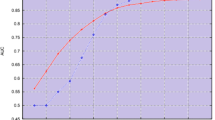Abstract
For many learning algorithms, their learning accuracy will increase as the size of training data increases, forming the well-known learning curve. Usually a learning curve can be fitted by interpolating or extrapolating some points on it with a specified model. The obtained learning curve can then be used to predict the maximum achievable learning accuracy or to estimate the amount of data needed to achieve an expected learning accuracy, both of which will be especially meaningful to data mining on large data sets. Although some models have been proposed to model learning curves, most of them do not test their applicability to large data sets. In this paper, we focus on this issue. We empirically compare six potentially useful models by fitting learning curves of two typical classification algorithms—C4.5 (decision tree) and LOG (logistic discrimination) on eight large UCI benchmark data sets. By using all available data for learning, we fit a full-length learning curve; by using a small portion of the data, we fit a part-length learning curve. The models are then compared in terms of two performances: (1) how well they fit a full-length learning curve, and (2) how well a fitted part-length learning curve can predict learning accuracy at the full length. Experimental results show that the power law (y = a - b * x -c) is the best among the six models in both the performances for the two algorithms and all the data sets. These results support the applicability of learning curves to data mining.
Access this chapter
Tax calculation will be finalised at checkout
Purchases are for personal use only
Preview
Unable to display preview. Download preview PDF.
Similar content being viewed by others
References
S. Amari, N. Fujita, and S. Shinomoto. Four types of learning curves. Neural Computation, 4(4):605–618, 1992.
Yonathan Bard. Nonlinear Parameter Estimation. Academic Press, 1974.
C.L. Blake and C.J. Merz. UCI repository of machine learning databases, 1998. (http://www.ics.uci.edu/~mlearn/MLRepository.html).
C. Cortes. Prediction of Generalization Ability in Learning Machines. PhD thesis, Department of Computer Science, University of Rochester, New York, 1993.
L.J. Frey and D.H. Fisher. Modeling decision tree performance with the power law. In Proceedings of the Seventh International Workshop on Artificial Intelligence and Statistics. Morgan Kaufmann, 1999.
B.H. Gu, F.F. Hu, and H. Liu. An empirical study of fitting learning curves. Technical report, Department of Computer Science, National University of Singapore, 2001.
H. Gu and H. Takahashi. Exponential or polynomial learning curves?—case-based studies. Neural Computation, 12(4):795–809, 2000.
G.H. John and P. Langley. Static versus dynamic sampling for data mining. In Proceedings of the Second International Conference on Knowledge Discovery and Data Mining (KDD’96). AAAI / MIT Press, 1996.
C.M. Kadie. Seer: Maximum Likelihood Regression for Learning-Speed Curves. PhD thesis, Department of Computer Science, University of Illinois at Urbana-Champaign, 1995.
T. Lim, W. Loh, and Y. Shih. A comparison of prediction accuracy, complexity, and training time of thirty-three old and new classification algorithms. Machine Learning, 1999.
Tjen-Sien Lim. Users’ guide for logdiscr version 2.0, 1999. (http://recursive-partitioning.com/logdiscr/).
D. Michie, D.J. Spiegelhalter, and C.C. Taylor. Machine Learning, Neural and Statistical Classification. Ellis Horwood Limited, Campus 400, Maylands Avenue, Hemel Hempstead, Hertfordshire, HP2 7EZ, England, 1994.
F. Provost, D. Jensen, and T. Oates. Efficient progressive sampling. In Proceedings of the fifth ACM SIGKDD international conference on Knowledge discovery and data mining(KDD’99), pages 23–32. AAAI/MIT Press, 1999.
F. Provost and V. Kolluri. A survey of methods for scaling up inductive algorithms. Machine Learning, pages 1–42, 1999.
J.R. Quinlan. C4.5: Programs for Machine Learning. Morgan Kaufmann, San Mateo, CA, 1993. (http://www.cse.unsw.edu.au/quinlan/).
D. A. Ratkowsky. Handbook of Nonlinear Regression Models. Marcel Dekker, INC., 1990.
G.A.F. Seber and C.J. Wild. Nonlinear regression. Wiley & Sons, 1989.
Author information
Authors and Affiliations
Editor information
Editors and Affiliations
Rights and permissions
Copyright information
© 2001 Springer-Verlag Berlin Heidelberg
About this paper
Cite this paper
Gu, B., Hu, F., Liu, H. (2001). Modelling Classification Performance for Large Data Sets. In: Wang, X.S., Yu, G., Lu, H. (eds) Advances in Web-Age Information Management. WAIM 2001. Lecture Notes in Computer Science, vol 2118. Springer, Berlin, Heidelberg. https://doi.org/10.1007/3-540-47714-4_29
Download citation
DOI: https://doi.org/10.1007/3-540-47714-4_29
Published:
Publisher Name: Springer, Berlin, Heidelberg
Print ISBN: 978-3-540-42298-3
Online ISBN: 978-3-540-47714-3
eBook Packages: Springer Book Archive




